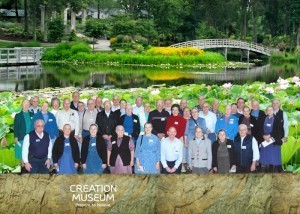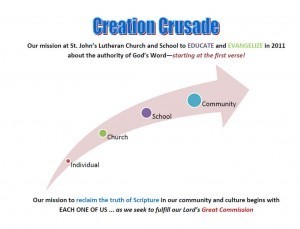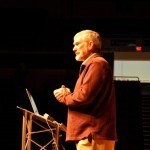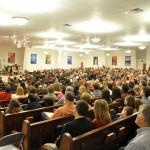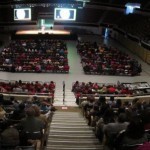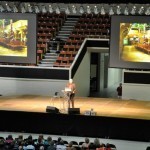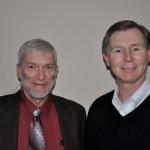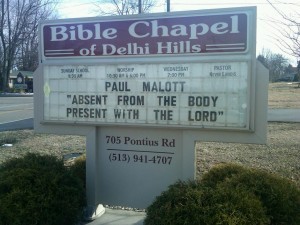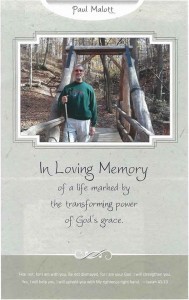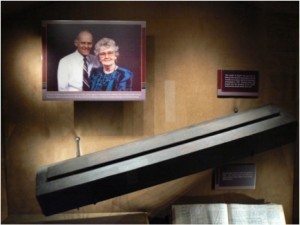Ken Ham's Blog, page 461
February 20, 2011
The Genesis Flood—The Battle Still Rages!
Friends,
This blog post is longer than usual, but I believe the subject matter required it. I hope you will take time to read it.
In the late 1700s and early 1800s, the idea of a long age (millions of years) for the earth was being popularized by deists, atheists, and other non-Christians. They were attempting to use a so-called "scientific investigation of the world" to justify their rejection of God and His Word. At the time, their primary target was to undermine the plain reading of the Bible concerning the Flood of Noah (and its consequence of rock layers and worldwide fossil deposits) and a young age for the earth. It was really their attempt to undermine the authority of the entire Bible.
At that time, there were church leaders who adopted these ideas (millions of years) into Scripture. This was no different than today, and really no different than what happened with the religious leaders in the Apostle Paul's day, and also no different to what was happening with the priests and false prophets in ancient Israel.
Fallible sinful man, ever since Genesis 3, has had the propensity to believe the fallible words of humans rather than the infallible Word of God. That is really our nature. At heart, because of sin, we are against God and what He teaches. People will go out of their way to trust in man rather than trust what God has clearly revealed.
In the early 1800s, there were church leaders in England who began to reinterpret the days of creation and the Flood account in Genesis to fit in the millions of years. Some advocated the idea of a gap between Genesis 1:1 and 1:2. Others said that Christians could interpret the creation days as long ages. Others realized that if one interpreted the fossil layers as representing millions of years, then how could one believe in the global Flood of Noah's day? Such a flood would destroy those layers and deposit more layers with fossils. Thus, it was postulated that Noah's Flood was only a local (regional) flood in the Mesopotamian Valley (modern-day Iraq).
As the nineteenth century progressed, Darwin popularized his ideas of evolution. There were church leaders who then reinterpreted Genesis to fit in evolution, even human evolution. When the idea of the big bang was popularized in the early twentieth century, in the same manner many church leaders then adopted this into God's Word.
Over the past 200 years, many different positions regarding understanding the creation account of Genesis have arisen in the church, such as the following:
Day Age idea
Gap Theory
Local Flood
Theistic Evolution
Progressive Creation
Framework hypothesis
There are other positions or variations on those listed above. But they all have one thing in common: trying to fit man's ideas of millions of years into the Bible.
A number of scientists who were Christians actually opposed these compromise positions. Various books and articles were written to challenge the church to stand on God's Word and not compromise with the fallible ideas of man that, intentionally or unintentionally, seriously undermined the authority of the Bible.
In February 1961, the book The Genesis Flood was published, authored by a scientist (Dr. Henry Morris) and theologian (Dr. John Whitcomb). This book dealt with the scientific and biblical aspects of the Genesis Flood account in Genesis 6–9, and challenged the church to stand on the authority of the Word of God and not reinterpret God's clear words in Genesis.
Today is the unofficial anniversary of the publication of this famous book that began the modern biblical creation movement. I encourage you to read the lead article on AiG's website today, commemorating this historic event.
Since the publication of this book, the biblical creation movement has grown. While the battle between God's Word in Genesis and the fallible ideas of man has changed somewhat, the same battle still rages today.
Since 1961, biblical creation scientists and theologians have been able to conduct tremendous research and have provided many answers in geology, biology, astronomy, anthropology, archaeology, and theology, which have equipped Christians to stand uncompromisingly on Genesis. The several thousand articles on the AiG website are a good example of providing such answers, as well as the hundreds of books, DVDs, and other resources now available.
The modern creation movement has been highly successful in pointing out to Christians of the inconsistencies in trying to add millions of years and evolution into the Bible. Many articles on the AiG website (or in the Answers magazine) deal with this issue.
Even with this wonderful research and its dissemination, the spiritual battle is intensifying. We don't fight against flesh and blood but "principalities and powers" (Ephesians 6:12). As more and more answers have been given, and inconsistencies pointed out, the arguments against God's Word in Genesis move on to different topics. This is why we continually need to be on our guard as we "contend for the faith" (Jude 3).
So where is the battle today? I have observed an interesting phenomenon that is permeating Christian colleges and seminaries, which influences future church leaders and what they take to the pulpit, mission field, etc.
I believe many Christian academics recognize the inconsistency in trying to add millions of years and evolution to Genesis. The compromise is obvious. Many of them recognize that one has to totally change the meaning of the words in Genesis to allow such compromise. For example, creating Adam out of dust and Eve from a rib have to be changed to mean that ape-men and ape-women changed into Adam and Eve. But this ignores many details in the biblical text and ends up playing language games. Various articles on the AiG website point out the numerous problems with such compromise. Ultimately, of course, the result of this compromise undermines the authority of God's Word. And in the church today, we see two thirds of young people leaving the church by the time they reach college age, and it's largely because the reliability and authority of God's Word has been undermined (as our research for the book Already Gone has shown).
Today, the same battle rages, but we see a change in what is being foisted on the church as the enemy continues to attack God's Word. Remember, the attack has always been on God's Word, as it started with the questioning of what God said to Adam and Eve in Genesis 3 and has never let up. That attack just manifests itself in different ways in different eras. I have observed that more and more Christian academics, in their attempt to adopt man's ideas of evolution and millions of years, are continuing this attack in a different sort of way. Let me give you some examples.
I will use the almost 1,000-page Dictionary of the Old Testament Pentateuch edited by T. Desmond Alexander and David W. Baker to illustrate where the battle is heading today.
On page 315, there is 12-page section on the Genesis Flood account written by John Walton, professor of Old Testament at Wheaton College in Illinois.
I wrote a recent blog post about Walton's approach to Genesis, pointing out that he believes Genesis 1 is not an account of material origins, but an account of God's "Cosmic Temple." Walton believes that a person needs to understand ancient Near-Eastern thinking and culture in order to understand Scripture. He argues that such an understanding has been lost for ages, but that academics like himself have been able to regain an understanding of this ancient Near Eastern thinking so the rest of us in the church can finally (after thousands of years) understand what Genesis 1 means. Walton certainly has a different view of inspiration to that of Drs Whitcomb and Morris, our AiG staff, and millions of other Christians around the world. Walton, though, looks at the person(s) who wrote Genesis and the pagan culture's of the day as authoritative. Morris and Whitcomb (and AiG and ICR—two of the leading creation apologetics organizations), however, understand that it is the words of Scripture that are inspired.
I think of this passage of Scripture: "All Scripture is given by inspiration of God, and is profitable for doctrine, for reproof, for correction, for instruction in righteousness"(2 Timothy 3:16).
In the original Greek language, "inspiration of God" is one word and it means literally "God-breathed." This verse clearly states that the words of Scripture are God breathed! Every one of them came from Him as the Spirit of God worked through the prophets and apostles. We are also told that God's Word will stand forever. If the infinite God, who created language, cannot move people to write His "God-breathed" words so all people (regardless of culture) can understand them, then there is something dreadfully wrong. If it is only now, after thousands of years, that we can finally understand what Genesis means because of what a few academics claim about ancient Near-Eastern thinking, how can we be sure we know anything? How do we know those academics like Walton have it right? No wonder Scripture cautions us that "knowledge puffs up." We are seeing academia in the Christian world going mad as "Protestant popes" are popping up all over the Christian world.
Regarding the Flood, Walton applies the same misguided approach as he does in Genesis 1. He states the following:
The theological message of the Bible was communicated to people who lived in the ancient Near Eastern world. If we desire to understand the theological message of the text, we will benefit by positioning it within the worldview of the ancient cultures rather than simply applying our own cultural perspectives. (p. 315)
Walton then discusses ancient Near-Eastern mythology and relates it to Scripture and its book of Genesis. In essence, he is using pagan, idolatrous mythology to supposedly help enable us to understand what God and Moses really meant!
But really, the whole underlying reason for what he is doing (as I noted in my previous blog) relates to the ideas of millions of years and evolution. Walton recognizes that you can't fit millions of years and evolution into Genesis, so he is hoping to popularize an idea that Genesis is not revealing an account of material origins. Genesis chapter one, for instance, is supposed to be about God's Cosmic Temple and the function of the different creatures in that temple (which came into existence who knows when)!
So what does the Flood account mean then?
Walton declares the following:
It has already been suggested that the boat in Mesopotamian accounts may have served as a floating shrine. In its dimensions, the Genesis ark is much more realistic for a boat, though conceptually it may also represent a sanctuary where order is maintained floating on a sea of resurgent chaos. In this sense the Mesopotamian ark appears as a physical representation of a sanctuary, while the Genesis ark appears as a functional representation of a sanctuary. Creation both in the Bible and in the ancient Near East entailed deity bringing order while pushing back chaos . . . The forces of chaos were most consistently represented in the cosmic waters. In this sense, the flood represents a reversal of creation. This is more the case in the biblical account than in the ancient Near Eastern accounts, for in the latter there is no textual representation of re-creation. (p. 322)
Now that makes sense to the average person, doesn't it?! Why didn't any Jews or Christians before the twentieth century ever think of this?
While Walton insists that he does not propose his views as a response to millions of years and evolution, that is exactly what his underlying motive is. It is obvious when you read his writings carefully. For instance, Walton objects to a global Flood by bringing up the same old arguments that Morris and Whitcomb were confronted with and were answered in their book!
For instance, Walton makes the following claims:
It would be impossible to cover Mt. Ararat with the waters of the Flood. But this assumes Mt. Ararat existed before the Flood! This mountain is one that has undergone massive volcanism and uplift. If you were to smooth out the earth's surface and oceans basins, there is enough water on the earth's surface right now to cover the earth to a depth of about two miles. The oceans were not as deep and the mountains not as high before the Flood. There has been a lot of uplift—particularly associated with the ending of the Flood (as Psalm 104:6–9 tells us—and the promise in verse 9, which reflects God's rainbow promise in Genesis 9, shows that this passage is not referring to Day 3 of Genesis 1). That is why marine fossils are found near the top of Mt. Everest (and other high mountains); the mountains were not covered by the Flood but the once-horizontal sediments were tilted and raised up at the end of the Flood. One also can see evidence of this uplift at the Grand Canyon, where layers supposedly millions of years old were uplifted while they were still soft.
Walton brings up the old accusation that there are too many species of animals to fit on the Ark. First of all, God brought the animals to Noah; Noah didn't have to locate them. Secondly, God sent two (seven of some) of every kind, not species. There are good biblical and scientific reasons to conclude that many species or even genera are descended genetically from each original created kind. For example, only one male and one female of the dog kind (not two wolves, two jackals, two dingos, two poodles, two great danes, etc.) were needed. Far fewer animals were required than what Walton is imagining and claiming.
Walton states, "one must also explain how the animals today found only in Australia could have gotten to that continent" (p. 321). He needs only to purchase our New Answers Book 1—or just go to the AiG website—for a very plausible answer. Frankly, this academic has not done his homework.
Walton states, "How could Noah and his family and animals such as elephants and hippopotami make the trek down the mountain (Mt. Ararat)" (p. 321). First, the Bible does not say the Ark landed on Mt. Ararat; it landed on the "mountains of Ararat," which this Hebrew expert should have known. So, the Bible doesn't tell us what particular mountain it was. The Mt. Ararat Walton refers to has undergone massive changes since the Flood: volcanism, earthquakes, and uplift. AiG's PhD geologist, Andrew Snelling, has stated that based on technical data that has been publicly available in maps and scientific papers for more than a decade, he is convinced that modern Mt. Ararat is almost certainly a post-Flood volcano, with most of its lavas having erupted during the post-Flood Ice Age. Therefore, the Ark most likely landed on some other mountain in that range. And unless Walton is going to say the Flood account is a myth, then it is obvious that Noah's family and all the animals could safely descend the mountain that they landed on so that they could repopulate the earth.
There are many more problems with what Walton states. But the bottom line is that he does not believe in a global Flood, and he does believe in an earth that is millions of years. In this section of the book, he certainly speaks positively about a possible regional event millions of years ago. He states, "If the reader finds it difficult to put the flood 5.5million years ago, the Black Sea theory may be more palatable" (p. 325). He really sums it up when he states, "There is presently no convincing archaeological evidence of the biblical flood." So, does he believe it was a myth? That belief would be contrary to the teaching of Jesus (Matthew 24:37–39) and the apostle Peter (2 Peter 2:4–6 and 3:3–7).
So the battle rages. It is the same battle Morris and Whitcomb were dealing with in their masterpiece The Genesis Flood. These great scholars were passionate for the Word of God. In the fifty years since their book's publication, the biblical creation movement is more passionate than ever for the Word of God. At the same time, we now see Christian academics like Walton using the argument that Genesis is not an account of material origins and that a Christian has to understand ancient Near-Eastern thinking to know what Genesis really means.
Walton's own arguments can be summed up this way; he states the following:
Some feel they are protecting theories that account of the details of the traditional interpretation of the text. Too often, however, these theories prove to be implausible and are easily discredited by the scientific thinkers whom they intend to win over. (p. 320)
Let me reword this for you (my words are interspersed in Waltons' and are in brackets to help explain what I believe Walton is saying):
Some [those like Whitcomb and Morris] feel they are protecting theories (protecting the clear teaching of the text) that account for details of the traditional interpretation of the text [the interpretation that greats like Luther, Calvin, Wesley, Gill, and others held because of what the text clearly states]. Too often, however, these theories [their views based clearly on the text—Scripture alone] prove to be implausible [to unbelievers, but not to Bible-believers] and are easily discredited by scientific thinkers [fallible sinful humans whose hearts are "deceitful above all things and desperately wicked," and who arrogantly claim that "science" has disproved the Bible's account because they insist millions of years are a fact] whom they intend to win over [who need to listen to God's Word but instead "suppress the truth in unrighteousness" (Romans 1:18)].
Today, let's praise God for the faithfulness of scholars like Whitcomb and Morris and for the publication of their book, The Genesis Flood. In some ways, this was the beginning of a new "reformation" in the modern church, which continues to this day as organizations like AiG, Institute for Creation Research, Creation Research Society, etc., continue to challenge the church and culture to return to the authority of the Word of God.
Thanks for stopping by and thanks for praying,
Ken

February 19, 2011
Special Visitors
We get to meet a lot of interesting visitors at the Creation Museum.
On Thursday of this week, the Creation Museum had a group of visitors from the Mennonite Disaster Service. Their leader, Mr. Paul Brubacher, said that the Mennonite Disaster Service has its national headquarters in Akron, Pennsylvania, and sends groups out all over the USA and Canada to provide manpower for the clean up, repair, and rebuilding efforts after natural disasters. They are an all-volunteer organization and have been functioning since 1950. They have 50 self-contained units throughout the USA. Here is a photo of the group taken when they visited this past Thursday:
Special Anniversary
Tomorrow is a special day: it is the unofficial fiftieth anniversary of the publication of the book that really started the modern biblical creation movement—The Genesis Flood. We will have a special lead article on our website, and I will write a blog post that will deal with a different "angle" on the topic of the Genesis Flood.
Thanks for stopping by and thanks for praying,
Ken

February 18, 2011
Wheaton College and False Teaching in Tennessee
Tomorrow, John Walton, the professor of Old Testament at Wheaton College in Illinois, will speak in the same church in Johnson City where I spoke last weekend. He is basically speaking on a topic that is related to his book—The Lost World of Genesis One.
I have read the book, and it saddens me to think of the false teaching that is rife in this publication. This teaching is obviously also being taught to his students at Wheaton and will be taught to those who turn up tomorrow to hear the professor speak. However, I believe the detailed teaching Dr. Jason and I—and the ICR speakers—gave this past week in Tennessee will help people to be able to be Bereans like those in Acts 17. They searched the Scriptures to see "if these things were so." When people compare John Walton's teaching with the plain reading of Scripture, they will find he is undermining biblical authority and using a form of academia to give an elitist view of how one is supposed to approach God's Word.
A summary of what Walton teaches includes the following:
Genesis 1 is not history in regard to the material world; it has to do with what he calls God's "Cosmic Temple." He basically insists that a person can only understand Genesis if that person has a understanding of the ancient Near Eastern thinking. And surprise, surprise, this thinking has been lost for thousands of years, and now a few academics like Walton have unearthed this way of thinking so now they can tell us what the writer of Genesis chapter 1 really meant! It is what I would call academic elitism.
Walton tries (unsuccessfully) to insist that he is not coming up with this new idea of his because of the influence of evolution/millions of years. But it's clear that he is doing just that! He knows that students today often have a conflict between the secular view of origins and the Bible, so his solution is to relegate Genesis 1 as having nothing to do with material origins and thus people are free to believe whatever they want. Though, he is obviously convinced that evolution and millions of years should be believed.
Bottom line, it is just another way of trying to come up with a "solution" to fitting millions of years and evolution into the Bible. Because Walton knows (and admits) that the days of creation are ordinary days in Genesis 1 according to the Hebrew language, he had to come up with a way to allow for millions of years and evolution yet agree that the days of creation are ordinary days. So what is his solution? Relegate Genesis 1 to mean it is the creation of God's "Cosmic Temple," and not allow it to have anything to do with material origins. Then he can say that students will have no conflict, and they can believe in millions of years, evolution, or whatever—it doesn't matter!
And of course, the reason the great church leaders of the past (whether Luther, Calvin, Gill, or whoever) never thought of this is because they did not discover how ancient Near Eastern cultures were thinking! This has now been discovered by an elite few who can now tell us for the first time in thousands of years what Genesis 1 really means. Sound bizarre? I encourage you to read the book for yourself!
Here are just a few quotes from the book:
Were Adam and Eve two real people? Walton says the following:
This archetypal understanding applies also to Genesis 2. An individual named Adam is not the only human being made of the dust of the earth, for as Genesis 3:19 indicates, "Dust you are and to dust you will return." This is true of all humans, men and women. It is an archetypal feature that describes us all. It is not a statement of chemical composition nor is it describing a material process by which each and every human being is made. The dust is an archetypal feature and therefore cannot be viewed as a material ingredient. It is indicative of human destiny and mortality, and therefore is a functional comment, not a material one. (Location 657–664, Kindle)
Is Genesis 1 an account of material origins? Walton declares the following:
When we thought of Genesis 1 as an account of material origins, creation became an action in the past that is over and done with. God made objects and now the cosmos exists (materially). Viewing Genesis 1 as an account of functional origins offers more opportunity for understanding that God's creative work continues . . . (Location 723–730, Kindle)
Genesis 1 would be viewed as a temple text-we gain a different perspective on the nature of the Genesis creation account. Genesis 1 can now be seen as a creation account focusing on the cosmos as a temple. It is describing the creation of the cosmic temple with all of its functions and with God dwelling in its midst. (Location 795–801, Kindle)
Was the Garden of Eden a real garden? Walton makes this statement:
The garden of Eden is not viewed by the author of Genesis simply as a piece of Mesopotamian farmland, but as an archetypal sanctuary, that is a place where God dwells and where man should worship him. Many of the features of the garden may also be found in later sanctuaries particularly the tabernacle or Jerusalem temple. These parallels suggest that the garden itself is understood as a sort of sanctuary. (Location 775–781, Kindle)
Does John Walton believe in millions of years? Walton says the following:
The day-age theory and others that attempt to mitigate the force of the seven days do so because they see no way to reconcile seven twenty-four-hour days of material creation with the evidence from science that the earth and the universe are very old. They seek a solution in trying to stretch the meaning of yôm, whereas we propose that once we understand the nature of the creation account, there is no longer any need to stretch yôm. (Location 867–874, Kindle)
Some variation exists as to whether the cosmic origins go back 10,000-20,000 years as some would allow, or only go back about 6,000 years from the present (as promoted at the Creation Museum in Petersburg, Kentucky). The challenge they face is to account for all of the evidences of great age of the earth and of the universe. (Location 1023–1031, Kindle)
Of course he believes in millions of years, and despite his insistence to the contrary, this is part of his ultimate motivation to relegate Genesis 1 to something other than material history.
So what does Walton say Genesis 1 means? Walton summarizes his thoughts here about Genesis 1:
In summary, we have suggested that the seven days are not given as the period of time over which the material cosmos came into existence, but the period of time devoted to the inauguration of the functions of the cosmic temple, and perhaps also its annual reenactment. It is not the material phase of temple construction that represents the creation of the temple; it is the inauguration of the functions and the entrance of the presence of God to take up his rest that creates the temple. Genesis 1 focuses on the creation of the (cosmic) temple, not the material phase of preparation. IN the next chapter we will track the implications of the idea that the seven days are not related to the material phase of creation. (Locations 867–874 and 874–877, Kindle)
There is so much more. He does not, for example, believe in a global Flood. He believes there was death of animals millions of years before man (however man came into existence).
There is a very telling statement I want to leave you with from Prof. Walton:
This is not a conclusion designed to accommodate science-it was drawn from an analysis and interpretation of the biblical text of Genesis in its ancient environment. The point is not that the biblical text therefore supports an old earth, but simply that there is not biblical position on the age of the earth. If it were to turn out that the earth is young, so be it. But most people who seek to defend a young-earth view do so because they believe that the Bible obligates them to such a defense. I admire the fact that believers are willing to take unpopular positions and investigate all sorts of alternatives in an attempt to defend the reputation of the biblical text. But if the biblical text does not demand a young earth there would be little impetus or evidence to offer such a suggestion. (Location 896–904, Kindle)
Well, he is correct here in one sentence: biblical creationists do insist on a young earth because we "believe the Bible obligates" us "to such a defense." Of course! But notice he is trying to see his conclusion is not "designed to accommodate science, " yet as you read the book, you find that is exactly what it is all about.
Why are we seeing more and more bizarre and elitist ideas (e.g., William Dembski—see previous blog post for details) coming out of Christian academia? I believe it is a form of academic pride, largely from academic peer pressure, because these people ultimately "loved the praise of men more than the praise of God" (John 12:43).
And why do I bother to bring such matters to the church's attention? I believe we need to be watchmen as described in Ezekiel and warn people about those who are on the attack. And in our day, many Christian academics are attacking God's Word by such false teaching as that above.
"Son of man, speak to the children of your people, and say to them: 'When I bring the sword upon a land, and the people of the land take a man from their territory and make him their watchman, when he sees the sword coming upon the land, if he blows the trumpet and warns the people, then whoever hears the sound of the trumpet and does not take warning, if the sword comes and takes him away, his blood shall be on his own head. He heard the sound of the trumpet, but did not take warning; his blood shall be upon himself. But he who takes warning will save his life. But if the watchman sees the sword coming and does not blow the trumpet, and the people are not warned, and the sword comes and takes any person from among them, he is taken away in his iniquity; but his blood I will require at the watchman's hand.'"
"So you, son of man: I have made you a watchman for the house of Israel; therefore you shall hear a word from My mouth and warn them for Me." (Ezekiel 33:2–7)
Over the next few months, we will be doing a lot more to call compromising Christian academics to account, so keep watch.
Thanks for stopping by and thanks for praying,
Ken

February 17, 2011
False Teaching Rife at Calvin College
More and more people are finding out what is really being taught at Calvin College in Michigan. For instance, Dan Harlow is professor of biblical and early Jewish studies in the Department of Religion at Calvin College. In a recent paper, he stated the following:
Recent research in molecular biology, primatology, sociobiology, and phylogenetics indicates that the species Homo sapiens cannot be traced back to a single pair of individuals, and that the earliest human beings did not come on the scene in anything like paradisal physical or moral conditions. It is therefore difficult to read Genesis 1–3 as a factual account of human origins. In current Christian thinking about Adam and Eve, several scenarios are on offer. The most compelling one regards Adam and Eve as strictly literary figures—characters in a divinely inspired story about the imagined past that intends to teach theological, not historical, truths about God, creation, and humanity. Taking a nonconcordist approach, this article examines Adam and Eve as symbolic- literary figures from the perspective of mainstream biblical scholarship, with attention both to the text of Genesis and ancient Near Eastern parallels. Along the way, it explains why most interpreters do not find the doctrines of the Fall and original sin in the text of Genesis 2–3, but only in later Christian readings of it. This article also examines briefly Paul's appeal to Adam as a type of Christ. Although a historical Adam and Eve have been very important in the Christian tradition, they are not central to biblical theology as such. The doctrines of the Fall and original sin may be reaffirmed without a historical Adam and Eve, but invite reformulation given the overwhelming evidence for an evolving creation. (Perspectives on Science and Christian Faith, Volume 62, Number 3, September 2010).
In response to feedback the college has received about what this professor believes and teaches (and he is just one of many with compromising beliefs at this "Christian" college), the office of the President of Calvin College stated the following:
What does Calvin College teach about evolutionary biology? Calvin affirms that the one true God is the creator and designer of the universe. The Calvin College Biology Department also clearly maintains that God, as the creator and designer of the universe, brought the world into being. With this as a firm foundation, the department also accepts the biological theory of evolution (descent with modification over time) to be the best explanation for understanding the commonality and diversity seen among all living creatures on earth. The department's Statement on Evolution can be found at http://www.calvin.edu/academic/biology/why/evolution-statement10May2010.pdf .
Over the next few months, I will be publishing more and more such statements from Christian colleges/seminaries as we lead up to the release of the sequel to Already Gone (where we examined why so many young people are leaving the church) called Already Compromised, which will be released in April.
If there is no literal Adam and Eve, no literal Fall, then there is no origin of sin and no need of a Savior. This false teaching at Calvin is destructive to biblical authority and the gospel.
Thanks for stopping by and thanks for praying,
Ken

February 16, 2011
It's Not That Complicated
Recently, I received an email from a lady who shared what she was doing in her Lutheran denomination as a result of hearing me speak on the book of Genesis. I asked her for permission to share her email with you, and she wrote the following:
My goal is to encourage others to realize "IT'S NOT THAT COMPLICATED" to start a few initiatives at your church and/or Christian school. The Lord can then do His work if we make the effort to open the right doors!
In her original email, she stated the following:
Ken, I wanted to take a minute to encourage you that your speaking events are changing lives. I was one of thousands honored to hear your speech last summer at Oklahoma City's Reclaiming America conference. God used your words to convict my heart that I had been undercutting His Word when I had been foggy and inconsistent in my understand and communication on creation. That conviction has led to action . . . and I share this, not to brag on what I'm doing, but rather to inspire other ordinary moms (or dads) to embrace this issue as the modern-day "Reformation" that's needed in the Church.
1. I developed — for our LCMS-Lutheran Church — an outline for a proposed Creation Crusade, which voters approved for 2011 (attached outline)
2. A centerpiece was booking Mike Riddle at our church-school in April for both the Sunday speaking sessions at the church, but also conducting a Saturday teacher/church worker training on Saturday and all-day sessions for area Lutheran/homeschool students on Monday.
3. I'm on a personal mission to make sure the national Lutheran school accreditation body adds intentional language and requirements for consistency in a biblically based science curriculum. (This has received very warm and enthusiastic support from the head of [a Lutheran schools association], and the issue will be brought up as a board recommendation at the next national meeting this summer.)
4. Along that line, the [Lutheran school group] is spotlighting our school's creation-revision efforts in the March magazine–which will go out to all Lutheran school administrators nationwide.
5. I'm guest-writing blogs on these worldview issues for my sister's growing ministry, called Frontline Moms. (Here's a link to today's post: http://frontlinemoms.com/2011/02/10/dinosaurs-basketball-and-one-frontline-mom/ ) If you can take the time to read, there's a couple of amazing encounters I had when sitting at a table marked, Creation Corner!
6. Additional steps at our church: adult Bible study series on creation by our pastor (using many of the Answers in Genesis DVDs as a basis), "Creation Corner" displays and giveaways at youth community basketballs games and upcoming community dances for middle school students, and a creation display at church with your AiG tracks as giveaways.
I'll continue to pray for your ministry, and for you to find ways of inspiring similiar efforts. I think there may be wisdom in AiG sponsoring a "creation re-creation" contest of some sort to encourage other churches/parochial schools to make similiar changes. (I think there's a marketing angle here, too, of bundling resources that you offer now as a "re-creation" packet.)
Blessings on your day and keep up the good work for His kingdom.
– Beth, Oklahoma City
More and more people like Beth are making a difference in their church and community as they take what they have learned and use it to reach others with the message of biblical authority and the gospel.
Thanks for stopping by and thanks for praying,
Ken

February 15, 2011
A Very Deliberate Baiting
Recently, the Creation Museum held a "Date Night" for couples to attend a presentation by myself on marriage, with a high-quality dinner and then a musical program. This time was set aside to celebrate marriage (obviously the biblical foundation of marriage—one man for one woman—as Genesis teaches), so couples could spend a relaxing evening together.
A blogger who has been vehemently opposing AiG, the Creation Museum, and the Ark Encounter project—often using vulgar language, false accusations, misinformation, and outright untruths—decided to raise money to send a "gay" couple to the Creation Museum's Date Night as an obvious deliberate attempt to make a scene.
The Creation Museum staff knew what this person was planning and so prepared accordingly. We had a special written statement prepared to read to this couple if they tried to attend in their deliberate attempt to bait us. Well, they did turn up—well, sort of—well . . . you need to read the whole story. They were turned away (well, one of them was—well, yes both were, but really it was only one person who was spoken to by our staff . . . you have to read the whole story).
This same person who deliberately set up this baiting attempt then wrote his "account" (well, it wasn't a true account, but you will have to read the whole story) of what he said supposedly happened, and then it spread through blogs through the internet and even into an alternative weekly newspaper in our state (Kentucky) that has opposed the Creation Museum in the past. The reporter for this paper never contacted AiG before this first report was written.
But to show you how these people deliberately tried to bait us and then distorted the facts even to downright untruths, read the lead article on our website today where we present the true account (with documentation) of what really happened. Go to this link to read the article.
What this shows is the increasing attempts to harass AiG, the Creation Museum, and Ark Encounter project just because there are people who disagree with certain viewpoints we hold. Doesn't the First Amendment guarantee the free exercise of religion and the freedom of speech in this nation? Some of these people say we are intolerant because we don't agree with "gay" marriage (because we build our thinking on the Bible and therefore take the view of marriage that Jesus taught in Matthew 19 for instance—a male and a female). But then those who claim we are intolerant are intolerant of our view! But in actuality, they are intolerant of us personally, which is why they try to harass us, bait us, and attack us with vulgar language and disseminate false information against us. Who really is the intolerant party here?! Bottom line is that there is an increasing intolerance against Christians who hold to the absolutes of Christianity in this nation.
Please make sure you read this article today.
Photographic Report on Tennessee Outreach
Saturday night through Monday afternoon, Dr. Jason Lisle and I were in Tennessee to speak at churches and then a conference in the Freedom Hall (a 6,000-seat arena). We praise the Lord that we spoke to around 10,000 total for the three days, including 4,000 children/young people yesterday at two students sessions. We received amazing testimonies. Here are a number of photographs that will give you a feel for the whole weekend:
I also encourage you to visit my public Facebook site to see two short videos and other reports on this exciting time in eastern Tennessee.
Thanks for stopping by and thanks for praying,
Ken

February 14, 2011
A Love Story—and In Memoriam
 What does a particular woodcarving in our Creation Museum have to do with Valentine's Day (being celebrated in the U.S. today)? I urge you to read today's lead article on our AiG website to find out, and discover how a heart-wrenching time in the lives of a devoted couple can encourage us on Valentine's Day. The article gives the account of two "love birds," Paul and Cindy Malott. Paul passed away several days ago, but his life and death became a wonderful testimony as Paul spent his final weeks sharing Christ to hospital staff and visitors. He had a number of opportunities to share the gospel.
What does a particular woodcarving in our Creation Museum have to do with Valentine's Day (being celebrated in the U.S. today)? I urge you to read today's lead article on our AiG website to find out, and discover how a heart-wrenching time in the lives of a devoted couple can encourage us on Valentine's Day. The article gives the account of two "love birds," Paul and Cindy Malott. Paul passed away several days ago, but his life and death became a wonderful testimony as Paul spent his final weeks sharing Christ to hospital staff and visitors. He had a number of opportunities to share the gospel.
Paul's artistic talent is on display inside the museum. For more on that, and to read a tribute to Paul's life, go to today's main web article.

The two love birds: Paul (wearing a Creation Museum shirt) and wife Cindy.
Here is Paul's obituary that appeared last week in the Kentucky Enquirer. It was mostly written by his granddaughter, I understand:
"I have fought the good fight, I have finished the race, I have kept the faith" 2 Timothy 4:7. Paul Malott did not waste his cancer but kept the faith throughout and finished his race well on February 5, 2011 at the age of 72. He is now united for eternity with his Savior. A life marked by the transforming power of grace, Paul was always eager to share the gospel of Jesus Christ.
His wife and sweetheart, Cindy Malott, shared life with him as they resided in Florida, Kentucky, and Ohio throughout their 28 years of marriage. He was a loving brother to John, father to Whit, Craig, Marci, and Elizabeth; a beloved "Papa" to thirteen grandchildren and two great grandchildren; and a kind friend to many treasured neighbors and anyone he met. As a gifted artist, he enjoyed wood-carving. And he had a special ability to fix just about anything.
His most recent job at Northern Kentucky Senior Services was indeed his favorite. His servant's heart and love for others was evident as he joyfully transported elderly, sick, and handicapped friends to medical appointments. He was an enthusiastic, loving, always-learning, and involved member of the Bible Chapel of Delhi Hills. Paul will forever be remembered by his fervent love for the Lord, his desire to learn from God's Word, his love for others, and the precious grace of a loving God exhibited so beautifully even in his final hours.
Instead of flowers and as a final encouragement to his wife, Cindy, the love of his life, he requested that any donations made in his honor be sent to Answers in Genesis in Petersburg, Kentucky to support the Sunday School Curriculum Project. His legacy of faith and trust in the Lord goes on.
I was not able to attend the memorial service on Saturday because of a speaking engagement in Tennessee, but I hear that it was a wonderful celebration of Paul's life. I heard that Christ was lifted up more than Paul at the service, which is what Paul wanted. AiG staff were involved in the service, including Elizabeth and Becky who sang at the service—they were accompanied by an internationally renowned violinist and his pianist wife. Pastor Kevin Landis, a great friend of the AiG ministry, led the memorial service at his church, Bible Chapel of Delhi Hills (Cincinnati). Here is a photo of the church sign from Saturday:
Also, here is the cover of the memorial program that was handed out at Saturday's service for Paul:
By the way, read this article for the answer to why God allows suffering and death in this world.
Please pray for Cindy and all the family. Thanks for stopping by and thanks for praying,
Ken

February 13, 2011
A German Visitor
While I was in Johnson City in Tennessee for a conference, back at the Creation Museum one of our FOTO FX photographers, Deb Minnard, had an opportunity to speak with a man from Germany who visited the Creation Museum yesterday. Deb sent me this report:
I just interviewed a very nice young man from Germany. He read about the Creation Museum in a German publication and decided to come to the US for the main purpose of visiting us. Today was his second day at the museum. He said this is his fourth visit to the US. His former visits were to visit his favorite uncle and tour the country.
He said he is amazed at the "liveliness" of the museum. He compared it against the churches in Germany that are irrelevant to people's lives. He's very impressed with the museum, saying that people come here with their families, eat, read, listen, and enjoy being here. It's nothing like any museum he's seen.
He would love to meet you. He's planning to come back to the meet and greet on Feb. 24th, just before going home . . . He gave me his email and would love to hear from you if you have a chance.
Overflow Crowd for First "Origins Conference" Event in Johnson City

Lots of children with their parents came last evening—here are three excited kids from one family
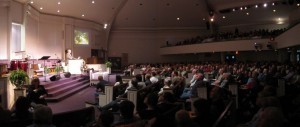
The auditorium
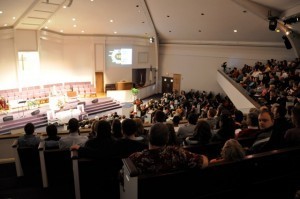
Another shot of a section of the auditorium

People crowded around the resource tables
As well as people in the overflow room, there was a group of people who received a simultaneous Spanish translation.
The conference continues today and tomorrow—with other speakers coming in this week (e.g., Dr. Henry Morris III from ICR). You can find out more about the conference on the AiG event page.
Thanks for stopping by and thanks for praying,
Ken

February 12, 2011
My Favorite Museum Exhibit
I often get asked what I consider my favorite Creation Museum exhibit to be. So I start mentioning my favorite exhibits—and end up listing all the exhibits! But really, there is one exhibit that to me stands out above all the rest—and it is one of the smallest exhibits. It is this one that is in the side of the chapel near the Last Adam Theater (where the gospel is very clearly presented in a video):
I have seen people standing in front of this exhibit with tears running down their face. When I have spoken to them, they have told me things like, "this exhibit challenges us in regard to what legacy we are leaving our children." Yes, this Creation Museum exhibit is a legacy of a father and mother who taught their children to stand uncompromisingly and boldly on the authority of the Word of God. It is a reminder of the spiritual legacy passed on from parents to children—and to the next generation and so on.
In Proverbs we read, "A good man leaves an inheritance to his children's children" (Proverbs 13:22 NKJV). This is a reminder that the most important legacy to leave is a spiritual legacy—it has eternal, priceless value.
I praise the Lord for a Dad and Mum who passed on such a spiritual legacy to me and my brothers and sisters—we are now passing this on to our children and they to their children. The reason I was reminded of this was because last night I spoke to a group of people who came to the special "Date Night" held at the Creation Museum. I spoke on marriage and love and the importance of passing on a spiritual legacy.
In Tennessee
Today I am in Johnson City, Tennessee, to speak in two churches and at a public venue as Dr. Jason Lisle and I bring an AiG conference and other speaking engagements to the area. You can find out details from the AiG website (www.answersingenesis.org). Look on the left under "Ken's Events" and you will see the three links for the three major events I will be speaking at.
Follow Me on Facebook
If you don't' already do so, I encourage you to follow me on Facebook—I put lots more interesting information there for our supporters to read. Go to: www.facebook.com/aigkenham
Thanks for stopping by and thanks for praying,
Ken

February 11, 2011
Fleas with More Genes Than Humans
A recent news item on the number of genes in a water flea prompted AiG researcher Dr. Georgia Purdom (her doctorate is in molecular genetics) to write a short blog post. I have reproduced her post below, as it is such an interesting item:
The water flea, genus Daphnia, is a small (1–5 mm) crustacean known to inhabit bodies of water all over the world. Its genome (DNA in the nucleus) was recently sequenced and found to contain a remarkable 31,000 genes. Humans are only estimated to have 20,000–25,000 genes. Why are so many genes needed for such a small and relatively simple (in comparison to humans) organism? Unlike humans, water fleas have to deal with their environment. I usually put it this way—they can't come in from the rain (or snow, etc.) so they have to adapt or die. God designed the water flea with an amazing spectrum of genes and mechanisms to change its phenotype (characteristics) to allow it to adapt to a wide range of environments. Dieter Ebert, in an article about the research, stated the following:
Water fleas react to chemicals (kairomones) released by different predators by expressing highly specific characteristics, such as protective tail spines, helmets, and neck teeth. They are also able to adapt physiologically to wide ranges of pH, toxins, oxygen concentrations, food, and temperature regimes. Moreover, maternal effects allow them to prepare their offspring for environmental challenges, including infectious disease, and the offspring's sex depends on the mother's environmental conditions.[1]
Amazing—even the mother water fleas can "prepare" their offspring before they are born for what they will face in the environment.
When I talk to children's assemblies and include the platypus as an example of remarkable design, I tell them about its interesting mix of features (e.g., bill like a duck, beaver-like tail, hair like a bear, web feet like an otter, claws like a rooster, and poison like a snake). I tell the kids that if the platypus evolved, it must have evolved from everything! All this is just to help them understand how the platypus is a "mosaic"—it has features of birds, reptiles, and mammals. I sometimes tell them that I think that every time an evolutionist looks at a platypus, I think that God "smiles," as I think He made it just for them!
Well, I think God also smiles when evolutionists look at the water flea! Such a tiny creature, and it has more genes than a human! I love it!
You can access Georgia's fascinating blog here.
Thanks for stopping by and thanks for praying,
Ken

Ken Ham's Blog
- Ken Ham's profile
- 353 followers


